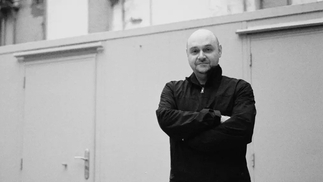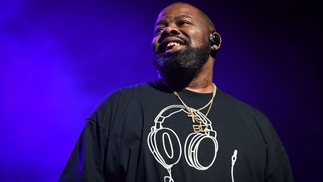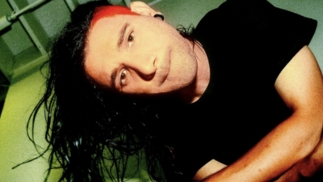BEARDYMAN: INFINITE POSSIBILITIES
Beardyman is turning music making into a sport with his One Album An Hour show...
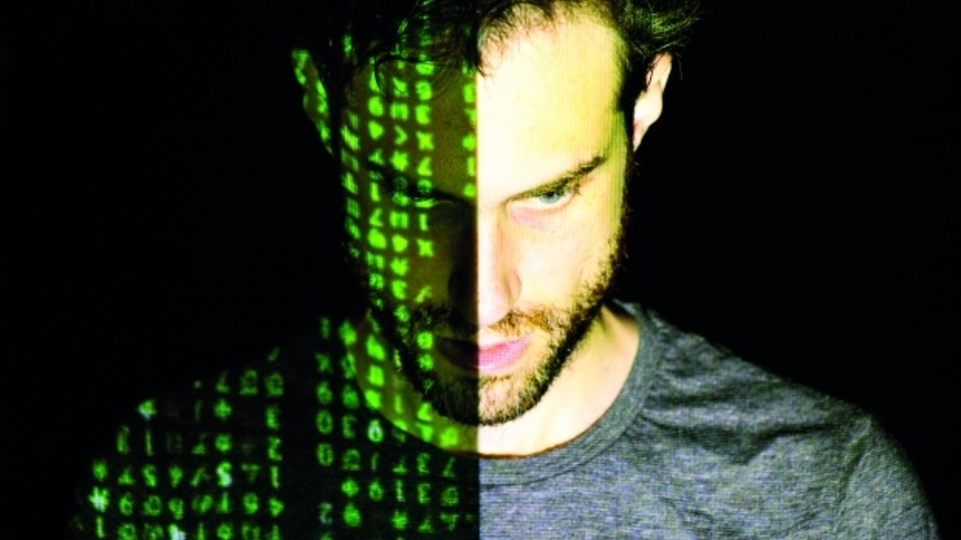
He's a funny sort of bloke, is Beardyman. Quite literally; a career founded on quick wit, and what he describes as the “inherently silly” art of beatbox, has seen to that. In a broader sense though, Darren Foreman — the man behind the beard — is difficult to pin down.
Much more than the 'comedy beatboxer' label he is so often given, Foreman is a serious musician. His 'Distractions' album was one of the most intriguing of 2014, marking a pivotal point in his journey beyond the stage.
Online, the Londoner has also become somewhat of a YouTube poster boy, through his One Album Per Hour shows, which saw Beardy hook up with Google for the world's first live broadcast interactive jam, collaborating musically with Jack Black from opposite sides of the Atlantic.
Foreman is, in fact, a technological mastermind, who won't let anything stand in his way — even if it means pushing beyond the limits of conventional production techniques. And how does he achieve all this, you ask?
“Not having a job helps,” jokes Foreman (we still suspect he's part robot, but we'll believe him for now). DJ Mag has dragged him away from his monstrous creation, the Beardytron 5000 MKIII, a custom-built software interface, three years in the making.
“It's all part of my fiendish plan really, which is basically to be able to make music, as quickly as possible, in the most fun way that I can imagine,” Foreman explains. The Beardytron certainly does that; comprised of four iPads and two laptops the system allows him to record, loop and manipulate his voice in just about any way he desires.
In turn, this has enabled Foreman to develop his live performance, and gain a new level of creative control. “The shows I was doing three or four years ago, they were comedy, and they were funny to me because my tech was so bad that if I wanted to do an idea, then it would be more funny that it was good,” he recalls.
“But the thing is now, that I've been working so hard on my system that it doesn't need to be funny, because it's actually just really good.” Excited about a fresh run of One Album Per Hour shows coming later this year, Foreman is enthused by the prospect of complementing the humorous nature of his performance with music that is more than just a “comedic, shitty sketch” of what he wanted to create.
THE BEARDYTRON IS BORN
Although musicianship has always been an integral part of Foreman's act, the widespread acclaim for his recent labours has been directed, far more, at his musical and creative abilities than his jokes.
Foreman believes his comedic roots haven't hindered him in being taken seriously in the past, yet he understands the difficulties of being pigeonholed. “When you become known for doing one particular thing, people want to see exactly what they love about what it is you do,” he laments. Luckily for Foreman, he is able to counter this effect and enjoy the best of both worlds; whilst his comedy performances revolve around music, he likes to round off his dance sets with a bit of fun, “like a nice encore”.
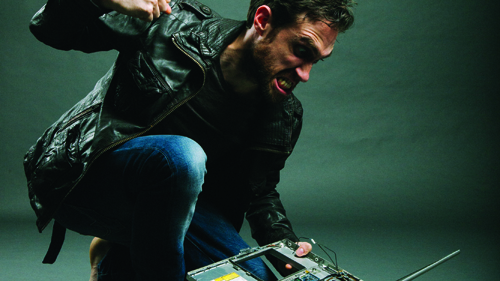
Foreman admits he finds the entire concept of beatboxing rather amusing. “It's just always seemed hilarious to me,” he chuckles, “there's always been something intrinsically funny about beatbox, because you're basically blowing raspberries, very fast and loudly, to a whole room full of strangers, and trying to seem hard. Even when I'm going really hard at it, and just doing some really dope beats, inside I'm laughing.”
Quick to dispel an notion of disrespect this statement may conjure up, Foreman goes on to speak encouragingly of the current beatbox scene and how far it's progressed.
Clearly still infatuated with the craft, Foreman continues: “If you're watching beatboxing in a room that's got a ridiculous soundsystem, and there's some really gorgeous pre-amps and compressors and a really good mic, it sounds fucking immense”. A pretty impressive feat for something that's essentially just “farting a lot with your face”.
Getting a simple beatboxing session to sound good was never the real problem though, Foreman explains, it was going beyond that.
“I guess it was not so much a dissatisfaction with the sounds I could make, it was more like a fascination with the possibilities,” he enthuses, “like, 'how far can I take this?' 'How far can I actually push the idea of being able to think things into existence?'”
Foreman believes that the key lies in knowing your instrument, and what could you know better than your own mouth? “If you've got a looper to use and you've got your voice, there's very little barrier between your creativity and the thing existing in the world,” he concludes.
The only trouble with Foreman's vision was he lacked the technology to realise it. Now, that's not to say he didn't own enough tech — old Beardy sets were constructed via a mountainous array of Kaoss Pads, keyboards and other assorted hardware.
“You're talking an articulated lorry full of shit,” says Foreman, “no, you really are.” Yet Foreman was far from content with what all his gear could actually achieve. “Things would never quite stay in time; the maximum loop time I had was like four bars, which is not enough to do certain things; the sound quality was bad, it was very hissy,” he gripes.
“Whatever you did, things were just bad.” His frustration with the limited technology at his disposal drove Foreman almost to the point of giving up, but, ever the dreamer, he instead dedicated himself to building a better machine. Thus, the Beadytron was born.
Running what he claims is “as good a synth workstation as any producer would want” on one laptop, and the “world's most advanced looper” on the another, Foreman uses tightly synced VST plug-ins to alter recordings on-the-fly, and quickly structures tracks using macros.
The Beardytron even allows Foreman to smoothly transition between radically different tempos through resampling. “Say when I want to transfer from techno into drum & bass; you've got techno plodding along,” he begins, busting out a slow four-to-the-floor rhythm.
“But if you put a beat repeat on the end of that, what you can actually do is keep that beat repeat going, and sample four or eight iterations of that loop,” he continues, kicking up his beatboxing into a d&b lick.
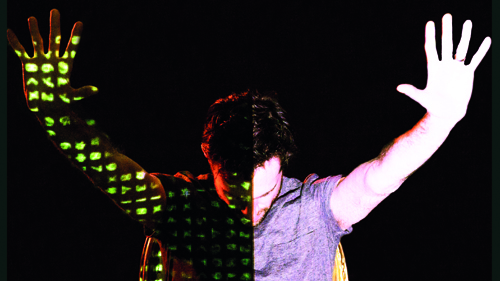
CYBORG MUSIC
That's not the end of it either; Foreman's contraption boasts three iPads running bespoke software, which offers a huge variety of functions, such as waveform feedback over Wifi.
Foreman reveals he may release his inventions to the public in the future, although nothing is set in stone. He understands his personal limitations, particularly under a busy touring schedule, and as a music tech junkie, knows that if you're going to release a product, you have to make sure it's definitely going to work.
Nevertheless, the Beardytron has already been hailed by some as the future of music, even if only in the sense that it's something genuinely new, set against a musical environment seemingly stuck in a loop of its own.
Foreman tells DJ Mag that he's just the tip of the iceberg, however. “You've got loads of people who are nutters, building their own musical instruments, who you never hear about unless you go out of your way to find out about them... the only people at the very top of that pyramid are people like Imogen Heap and... well, it's really just Imogen Heap.”
Barely avoiding fanboy levels of wonderment, Foreman explains Heap's complex Mi.Mu gloves, with which she can control sounds with gestures, performing grain cloud synthesis and playing invisible instruments with a swish of her hand.
“You've got people like Onyx Ashanti,” he continues, “who is a good friend of mine and is completely insane. He's turned himself into a cyborg using a 3D printer and his bat-shit thoughts! He's so crazy, and he makes music that is just mind-bending and unpalatable and weird, but god bless him, he's a genius.
“I'm actually part of something a lot bigger, which is this kind of maker movement, and I'm not even really part of that as much as some are,” says Foreman, but whilst many toil away undiscovered, the famous face of Beardyman has helped encourage other prominent musicians to get onboard with Foreman's way of thinking.
Recently the Londoner hosted the Jazz Cafe's 25th anniversary celebrations, performing live with the likes of drummer Andy Gangadeen, Captain Beefheart guitarist Gary Lucas, and vocalist Dizraeli. Meanwhile, recording for the next Beardyman album is already underway, with Foreman recruiting an “insane bunch of people” for what is to be a fully collaborative work.
Foreman is certainly no stranger to collaboration — after all, his biggest hit, 'Eat, Sleep, Rave, Repeat', is of course a joint project with Fatboy Slim and Riva Starr.
He describes how he loves the challenge of working with others: “It's really cool to sort of stretch yourself to fit another person's expectations,” he tells DJ Mag, “or if another person is bringing loads of energy and talent, it makes you raise your game...
you sort of merge souls when it's really good, especially if you're there live in the room, then you manage to do things that neither of you would have done if you weren't together.
“It's like fucking,” Foreman announces with a giggle. “The audience that you're playing to, you're essentially having sex with them; if they're not enjoying it, that's really bad and you should stop; if you're not enjoying it, that's really bad and you should stop.
Let's be clear, with the audience, you're fucking them,” he continues, laughing. “So you have to fuck them really good, you have to take them on a journey. You're in it together, y'know, so I think the same is true about musical collaborations; you're creating shared moments of pleasure, but if you're having sex on your own it's not quite as much fun.
Foreman points to his desire to work under pressure, as the explanation behind his obsession for pushing real-time recording techniques. Learned in improvisational theory, he cites the work of King Crimson's Robert Fripp, David Bowie, comedian Stewart Lee, and the surrealist automatism artwork of André Masson as inspirational examples.
He enjoys the fact that in a live setting he can't go back to fiddle with tracks and accidentally spoil them. “It's a preferable challenge for me, to doing something and then having to leave it alone,” he jests, explaining how live composing is a huge thrill to watch as you get to witness the entire creative process.
“For me, that turns music into a sport,” he continues, “y'know, you go to see a sports game of any kind, you don't know what the result's gonna be, and that's really exciting.”
words: BEN HINDLE
